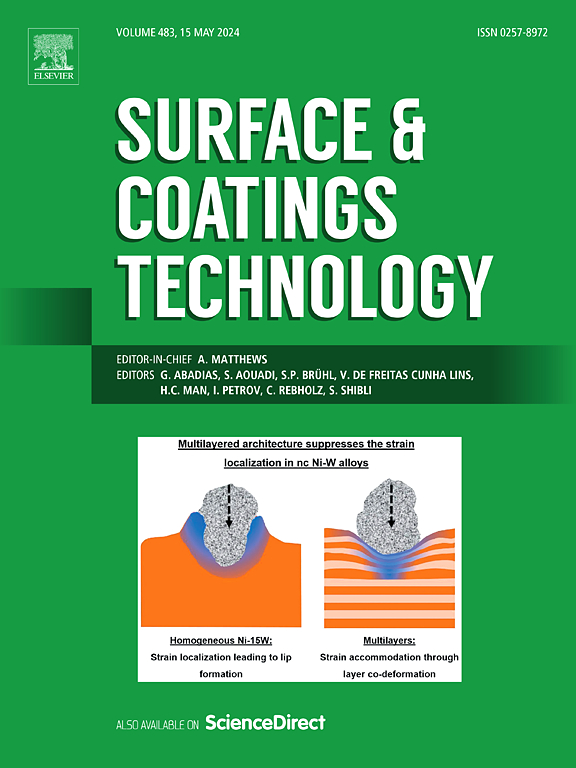纳秒激光与化学官能化相结合的双相处理钛的疏水表面
IF 5.3
2区 材料科学
Q1 MATERIALS SCIENCE, COATINGS & FILMS
引用次数: 0
摘要
采用纳秒激光对空气进行功能化,对钛表面进行双相处理,产生粗糙的氧化膜及其随后的化学修饰,目的是获得适合自清洁和微流体应用的高度疏水表面。利用λ = 532 nm的脉冲纳秒Nd:YAG激光器制备了最大粗糙度为45 μm的富锐钛矿锯齿形衬底。以四氢呋喃(THF)或沸水溶液形式对激光处理表面进行了辛基膦酸(OPA)的化学改性。研究了改性剂浓度在10−2 ~ 100 mM范围内对有机负载、层结构和接触角的影响。采用SEM-EDS/WDS、XPS、XRD和拉曼光谱对复合材料表面进行了表征。结果发现,OPA溶液在THF中只形成了单层膜(~ 13 Å),在4.8 at左右完成了表面覆盖。根据XPS % P负载。OPA的浓水溶液产生额外的辛基膦酸钛覆盖层,使有机层的总厚度达到25-29 Å,最大P量接近8at .%。尽管有机层的性质不同,但所有表面都至少承受2.2英寸。% P显示类似的静态接触角约155°。基于动态接触角测量,证实了OPA单层和辛基膦酸钛(IV)覆盖层表面的超疏水行为。本文章由计算机程序翻译,如有差异,请以英文原文为准。
Hydrophobic surfaces by duplex treatments of titanium combining nanosecond laser processing and chemical functionalization
Duplex treatment of titanium surfaces that consists in a nanosecond laser functionalization on air producing a rough oxide film and its subsequent chemical modification was investigated with the goal of obtaining highly hydrophobic surfaces suitable for self-cleaning and microfluidics applications. A pulsed nanosecond Nd:YAG laser with λ = 532 nm was used for the creation of anatase-rich sawtooth patterned substrates with a maximum roughness of 45 μm. The chemical modification of laser-treated surfaces with octylphosphonic acid (OPA) in the form of tetrahydrofuran (THF) or boiling water solutions was performed. The effect of modifier concentrations ranging from 10−2 to 100 mM on the resulting organic load, layer structure and contact angles was investigated. The duplex-treated surfaces were characterized by SEM-EDS/WDS, XPS, XRD and Raman spectroscopy.
It was found that OPA solutions in THF resulted exclusively in the formation of monolayers (∼13 Å), with the completion of surface coverage at around 4.8 at.% P load according to XPS. Concentrated aqueous solutions of OPA produced an additional titanium (IV) octylphosphonate overlayer which brought the total thickness of organic layer to 25–29 Å at a maximum P amount approaching 8 at.%. Despite the different nature of the organic layers, all surfaces bearing at least 2.2 at. % P showed similar static contact angle of about 155°. Based on dynamic contact angle measurements, superhydrophobic behavior was confirmed both for the surfaces bearing complete OPA monolayers and titanium (IV) octylphosphonate overlayers.
求助全文
通过发布文献求助,成功后即可免费获取论文全文。
去求助
来源期刊

Surface & Coatings Technology
工程技术-材料科学:膜
CiteScore
10.00
自引率
11.10%
发文量
921
审稿时长
19 days
期刊介绍:
Surface and Coatings Technology is an international archival journal publishing scientific papers on significant developments in surface and interface engineering to modify and improve the surface properties of materials for protection in demanding contact conditions or aggressive environments, or for enhanced functional performance. Contributions range from original scientific articles concerned with fundamental and applied aspects of research or direct applications of metallic, inorganic, organic and composite coatings, to invited reviews of current technology in specific areas. Papers submitted to this journal are expected to be in line with the following aspects in processes, and properties/performance:
A. Processes: Physical and chemical vapour deposition techniques, thermal and plasma spraying, surface modification by directed energy techniques such as ion, electron and laser beams, thermo-chemical treatment, wet chemical and electrochemical processes such as plating, sol-gel coating, anodization, plasma electrolytic oxidation, etc., but excluding painting.
B. Properties/performance: friction performance, wear resistance (e.g., abrasion, erosion, fretting, etc), corrosion and oxidation resistance, thermal protection, diffusion resistance, hydrophilicity/hydrophobicity, and properties relevant to smart materials behaviour and enhanced multifunctional performance for environmental, energy and medical applications, but excluding device aspects.
 求助内容:
求助内容: 应助结果提醒方式:
应助结果提醒方式:


